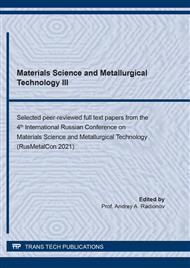p.221
p.227
p.233
p.238
p.244
p.250
p.256
p.262
p.267
Research of Ferronickel Manufacturing Process by Selective Reduction of Poor Iron-Chromium-Nickel Ores
Abstract:
In metallurgy production nickel is an important alloying element used in the production of stainless, heat-resistant, acid-resistant grades of steel. For the development of ferronickel production in the Russian Federation, it is proposed to involve in processing complex poor iron-chromium-nickel ores of the Khalilovskoye deposit, which are not used at the present time. In the frame of this work the dependences of the elements reduction degrees of iron-chromium-nickel ore on the iron extraction degree were studied. These dependencies are necessary for the choice of the composition and development of ferronickel production technology. Burned ore raw materials were subjected to a selective carbothermal reduction in the laboratory electric arc furnace. In the obtained ferroalloy the nickel content decreased from 65 to 3%, phosphorus - from 0.68 to 0.38%, sulfur - from 0.19 to 0.10% with an increase in the reducing agent consumption. With the reduction of 1% iron, the recovery of nickel was only 50%, with 5% - 65–75%, with 20% - 95%. The content of iron oxides in the partially reduced melt with an increase in coke consumption decreased from 61 to 53%, and nickel oxide - from 0.192 to 0.010%. The analysis of the dependences allows us to make a conclusion that it is inappropriate to recover less than 5% of iron due to the low degree of nickel recovery (less than 70%). The rational degree of iron reduction from ore raw materials is 5-10%, which corresponds to the nickel content in the ferroalloy 10-20%, phosphorus - 0.3-0.5%, sulfur - 0.08-0.09%. Obviously, the resulting crude ferronickel needs refining, first of all dephosphorization.
Info:
Periodical:
Pages:
244-249
Citation:
Online since:
February 2022
Authors:
Keywords:
Price:
Сopyright:
© 2022 Trans Tech Publications Ltd. All Rights Reserved
Share:
Citation:


